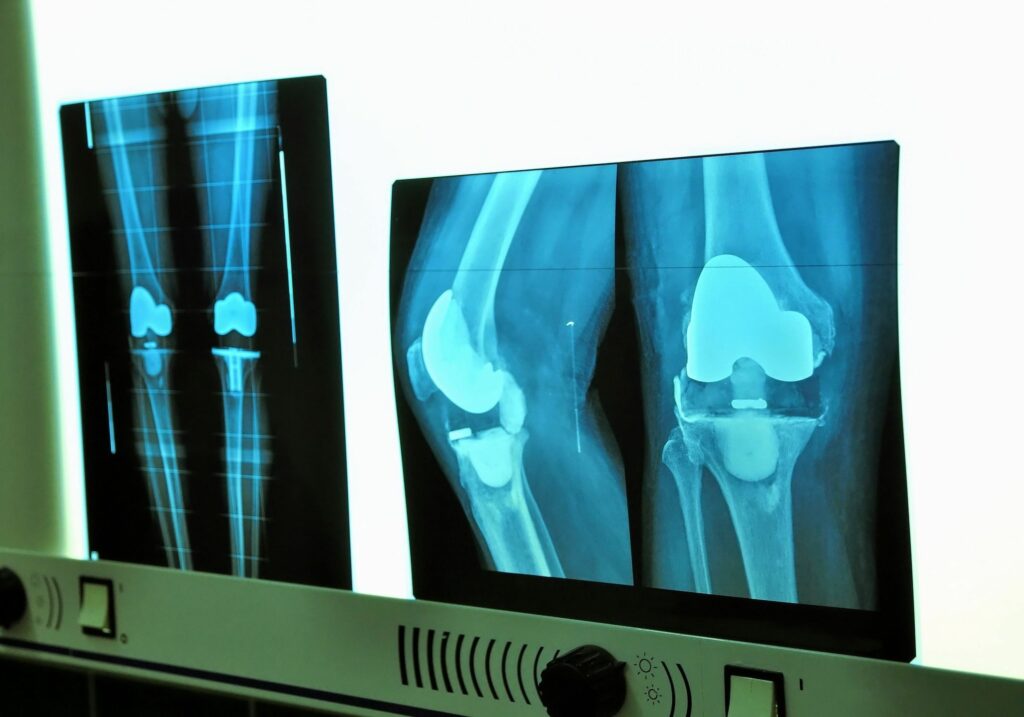Are you struggling to decide between partial and total knee arthroplasty? Plancher Orthopaedics will guide you through the key differences, benefits, and potential drawbacks of each type of knee replacement surgery, helping you determine “partial vs total knee arthroplasty which is best for you” based on your specific needs and lifestyle.
Key Takeaways
- Partial knee arthroplasty involves a less invasive surgery with quicker recovery times and a more natural-feeling knee, but it has a higher revision rate in later years and may not be suitable for all knee arthritis patients.
- Total knee arthroplasty provides comprehensive relief from extensive knee damage with long-term effectiveness, but it requires a longer recovery period and carries risks such as infections, blood clots, and the need for potential revision surgeries.
- The decision between partial and total knee arthroplasty depends on factors such as the extent of knee damage, overall health, and patient preferences, with careful preoperative evaluations guiding the planning and execution of the surgery.

Understanding Knee Arthroplasty
Knee arthroplasty is a surgical intervention that has transformed the lives of millions by offering an escape from the clutches of knee pain and immobility. When non-surgical treatments like physical therapy and medications no longer quiet the screams of severe arthritis symptoms, it’s time to consider knee replacement surgery.
To comprehend knee arthroplasty, one must grasp the nature of this life-altering surgery. It’s more than a procedure; it’s a rebirth for your knee joint, allowing you to stride without pain and partake in daily activities with ease. Total knee replacement surgery is a collective term for various surgical techniques aimed at bringing back the joy of movement to those hobbled by knee arthritis, the chief culprit behind knee pain.
Joint replacement surgery becomes a viable option when the grinding bone-on-bone pain becomes unbearable and conservative measures fail to provide relief. Whether it’s a partial knee replacement, preserving parts of your original knee, or a total knee replacement, overhauling the entire joint, the goal remains the same: to restore your knee’s function and alleviate the agony that’s been holding you back.
Types of Knee Arthroplasty: Partial vs. Total
Knee arthroplasty can be categorized into two main types: partial knee replacement and total knee replacement. Each path is tailored to the unique landscape of your knee’s damage. Partial knee replacement, also known as unicondylar knee replacement, unicompartmental knee replacement, or unicompartmental knee arthroplasty, is like a precise, targeted strike, honing in on only the affected compartment of the knee. It’s a beacon of hope for those whose arthritis has not yet claimed the entire joint, offering a less invasive option with a preservationist approach.
On the other battlefield stands total knee replacement, a more comprehensive strategy that replaces the entire knee joint, leaving no trace of the damaged cartilage behind. This procedure is the heavy artillery, called upon when the damage extends across all three compartments of the knee, demanding a more aggressive intervention. As we delve deeper, you’ll discover the nuances that make each approach unique and the factors that steer the decision between preserving just one compartment or opting for a full joint overhaul.
Benefits of Partial Knee Arthroplasty
Partial knee arthroplasty offers a less invasive approach, a quicker recovery, and a more natural-feeling knee. Smaller incisions mean you can expect a swifter return to your daily life, with most patients resuming activities within a mere six weeks. The beauty of partial knee surgery lies in its precise nature, preserving the healthy parts of your knee and focusing solely on the damaged cartilage.
Patients often find that the reduced surgical footprint leads to less postoperative discomfort, minimal blood loss, and a hospital stay that’s more of a brief interlude than a prolonged saga. Imagine a recovery where pain and swelling are managed with simple measures, and the stiffness that once plagued your steps fades into memory. Moreover, a partial knee replacement often spares the need for extensive physical therapy, setting the stage for a rapid return to the activities you love.
Benefits of Total Knee Arthroplasty
For those with extensive knee damage, total knee arthroplasty acts as a powerful means of pain relief, providing freedom from chronic pain and enabling a return to activities once limited by arthritis. The procedure is not just a surgery; it’s a transformation, gifting patients with improved joint function and the ability to move freely without the chains of discomfort. It’s a comprehensive solution, especially for those whose knee pain has spread far and wide, infiltrating all compartments of the joint.
The long-term benefits of total knee arthroplasty echo through time, with about 90% of knee implants remaining functional two decades down the road. Patients often report a newfound independence, able to perform daily tasks without the need for pain medications or assistance.
The echoes of satisfaction from individuals who’ve undergone the procedure resonate, with improvements in knee function and pain reduction standing as testimony to the procedure’s efficacy.
Drawbacks of Partial Knee Arthroplasty
Despite the numerous benefits of partial knee arthroplasty, some challenges can arise. The procedure shines during the first-decade post-surgery, but the shadow of a higher revision rate looms in the later years. It’s crucial to recognize that arthritis is a cunning foe, potentially progressing in other areas of the knee not addressed by the partial replacement.
Partial knee replacements are not one-size-fits-all; they’re not recommended for knee replacement patients with significant angular deformity or marked stiffness, and they demand a surgeon with a precise and practiced hand. Even with the most skilled orthopaedic surgeons, complications such as instability, implant loosening, or nerve injury can arise, albeit in a small percentage of cases. In contrast, partial knee replacement compared to knee replacement surgeries, including full knee replacement, might be a more suitable option for some patients.
Drawbacks of Total Knee Arthroplasty
Despite its benefits, total knee arthroplasty comes with its own set of challenges. The longer incisions and more extensive surgery translate into a longer convalescence, a longer wait before you can reclaim your life’s rhythm. Complications, though relatively rare, are a reality, with a small contingency of patients facing infections and blood clots, or the specter of ongoing pain.
The longevity of a knee implant is not infinite; over time, the wear and tear of life may necessitate a return to the operating room for a revision surgery to replace worn components. The early re-operation rate also tends to be higher for total knee replacements, adding a layer of risk for patients who have just begun to enjoy their newfound mobility.
Decision-Making Factors
The decision between partial and total knee arthroplasty is influenced by factors unique to each patient’s condition and lifestyle. Your knee’s story, the extent of the damage, and the chapters of your life all play pivotal roles in this decision. The state of your overall health, including the presence of heart or lung disease, can tip the scales toward one procedure over the other, demanding careful consideration.
Age is but a number, yet it whispers advice in the surgeon’s ear; partial knee replacements often find companionship with patients over the age of 40. Ultimately, the harmony of patient and surgeon preferences, clinical indications, and potential surgical risks will orchestrate the final choice between a total or partial knee replacement.
Preoperative Evaluation for Knee Arthroplasty
Before embarking on the journey of knee arthroplasty, a thorough medical evaluation is necessary to plan the course of treatment. Your history, previous interventions, and the current tale of your knee’s woes will influence the surgical narrative. The examination extends beyond the knee, exploring the range of motion in neighboring territories like hips and ankles, ensuring the vascular status is robust enough for the voyage ahead.
Radiographs act as the scout, revealing the knee’s alignment and the extent of bone loss, while advanced imaging sharpens the surgeon’s knowledge of the knee’s inner landscape, guiding the planning of the surgical approach. These evaluations form the cornerstone of a successful surgery, ensuring that every step of your knee’s rebirth is meticulously planned and executed.
Postoperative Outcomes and Recovery
The postoperative journey can be a mix of triumphs and challenges, yet the overall positive outcomes and limited complications paint a hopeful picture for those undergoing either partial or total knee replacement. Yet, the individual threads of recovery are as varied as the patients themselves, with factors such as activity level and age influencing the need for customized recovery plans.
Pain, an unwelcome but expected guest, often requires a cocktail of management strategies to ease into the background. The promise of long-term relief stands on the horizon, with knee implants typically offering up to two decades of support. Partial knee replacements, with their faster recovery timeline, may see you returning to work or play within weeks, while those with total replacements may ask for a bit more patience from their calendars.
Resources and Support for Patients
Recovery from surgery is a collaborative process, involving the patient and healthcare professionals. Rehabilitation programs serve as the compass, guiding patients through the necessary steps toward regaining knee function and a return to normalcy. Physical therapy and guided exercises, monitored by the vigilant eyes of healthcare professionals, ensure that progress is both measured and celebrated.
The landscape of support extends to the realms of education and community. Brochures, online resources, and instructional videos empower patients with knowledge, while support groups provide a sanctuary for sharing experiences and drawing strength from fellow travelers on the journey of knee arthroplasty.
Contact Plancher Orthopaedics
As we reach the summit of our exploration, the view is clear: knee arthroplasty offers a path to lifelessness hindered by pain and immobility. Whether the journey calls for the targeted approach of partial knee replacement or the comprehensive strategy of total knee replacement, the destination is the same – a knee that bends to your will, not to the whims of arthritis.
Embrace the knowledge that, while challenges may arise, the success stories and satisfaction rates speak volumes of the transformative power of knee arthroplasty. As you contemplate the next steps on your path, let the lessons learned here be your guide, leading you toward an existence where each step is a testament to the wonders of modern medicine and the resilience of the human spirit. Contact Plancher Orthopaedics today and find out more on how we can help you benefit from knee arthroplasty.
Frequently Asked Questions
What is the main difference between partial and total knee arthroplasty?
The main difference between partial and total knee arthroplasty is that partial knee arthroplasty replaces only the damaged compartment of the knee, preserving more of the natural knee structures, while total knee arthroplasty replaces all three compartments, offering a comprehensive solution for extensive damage.
How long is the recovery period after partial knee arthroplasty compared to total knee arthroplasty?
Recovery after partial knee arthroplasty is generally faster, with most patients resuming daily activities within three to six weeks, while total knee arthroplasty recovery may take longer.
Are there age restrictions for partial knee replacement surgery?
Partial knee replacement surgery does not have strict age restrictions, but it is typically considered for patients over the age of 40. Other factors such as knee damage and overall health also play a significant role in determining suitability for the surgery.
Can a partial knee replacement be revised if it fails?
Yes, a partial knee replacement can be revised to a full knee replacement with a high success rate.
What are some potential complications of knee arthroplasty?
Potential complications of knee arthroplasty include infection, blood clots, nerve injury, and instability of the knee, among others. It’s important to be aware of these risks and discuss them with your healthcare provider.





 William D. Murrell, MD
William D. Murrell, MD Thomas B. Evely, DO
Thomas B. Evely, DO Clifford Voigt, MD
Clifford Voigt, MD Karthikeyan Chinnakkannu, MD
Karthikeyan Chinnakkannu, MD Max N. Seiter, MD
Max N. Seiter, MD Demetris Delos, MD
Demetris Delos, MD Lauren M. Fabian, MD
Lauren M. Fabian, MD